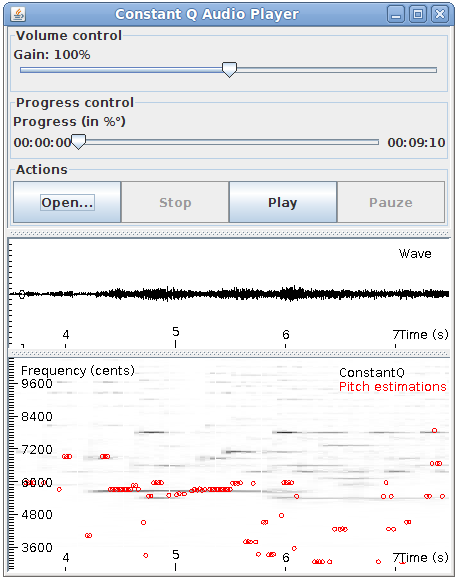» By Joren on Wednesday 09 October 2013
The DSP library for Taros, aptly named TarsosDSP, now includes an implementation of a Constant-Q Transform (as of version 1.6). The Constant-Q transform does essentially the same thing as an FFT, but has the advantage that each octave has the same amount of bins. This makes the Constant-Q transform practical for applications processing music. If, for example, 12 bins per octave are chosen, these can correspond with the western musical scale.
Also included in the newest release (version 1.7) is a way to visualize the transform, or other musical features. The visualization implementation is done together with Thomas Stubbe.
The example application below shows the Constant-Q transform with an overlay of pitch estimations. The corresponding waveform is also shown.
Find your oven fresh baked binaries at the TarsosDSP Release Repository.
The source code can be found at the TarsosDSP GitHub repository.
 Music Information Retrieval, Code, TarsosDSP, Java, HoGent, and Computational musicology
Music Information Retrieval, Code, TarsosDSP, Java, HoGent, and Computational musicology
 constantq-visualization-java.png
constantq-visualization-java.png
» By Joren on Wednesday 09 October 2013
 The journal paper Evaluation and Recommendation of Pulse and Tempo Annotation in Ethnic Music – In Journal Of New Music Research by Cornelis, Six, Holzapfel and Leman was published in a special issue about Computational Ethnomusicology of the Journal of New Music Research on the 20th of august 2013. Below you can find the abstract for the article, and the full text author version of the article itself.
The journal paper Evaluation and Recommendation of Pulse and Tempo Annotation in Ethnic Music – In Journal Of New Music Research by Cornelis, Six, Holzapfel and Leman was published in a special issue about Computational Ethnomusicology of the Journal of New Music Research on the 20th of august 2013. Below you can find the abstract for the article, and the full text author version of the article itself.
Abstract: Large digital archives of ethnic music require automatic tools to provide musical content descriptions. While various automatic approaches are available, they are to a wide extent developed for Western popular music. This paper aims to analyze how automated tempo estimation approaches perform in the context of Central-African music. To this end we collect human beat annotations for a set of musical fragments, and compare them with automatic beat tracking sequences. We first analyze the tempo estimations derived from annotations and beat tracking results. Then we examine an approach, based on mutual agreement between automatic and human annotations, to automate such analysis, which can serve to detect musical fragments with high tempo ambiguity.
To read the full text you can either download Evaluation and Recommendation of Pulse ant Tempo Annotation in Ethnic Music, Author version. Or obtain the published version of Evaluation and Recommendation of Pulse ant Tempo Annotation in Ethnic Music, published version
Below the BibTex entry for the article is embedded.
1
2
3
4
5
6
7
8
9
10
|
@article{cornelis2013tempo_jnmr,
author = {Olmo Cornelis, Joren Six, Andre Holzapfel, and Marc Leman},
title = {{Evaluation and Recommendation of Pulse ant Tempo Annotation in Ethnic Music}},
journal = {{Journal of New Music Research}},
volume = {42},
number = {2},
pages = {131-149},
year = {2013},
doi = {10.1080/09298215.2013.812123}
} |
 Research papers, featured, JNMR, and HoGent
Research papers, featured, JNMR, and HoGent
 2013.10.09.Tempo_annotation_in_ethnic_music-JNMR-Author_Version.pdf and jnmr.cover.jpg
2013.10.09.Tempo_annotation_in_ethnic_music-JNMR-Author_Version.pdf and jnmr.cover.jpg


 The journal paper Evaluation and Recommendation of Pulse and Tempo Annotation in Ethnic Music – In Journal Of New Music Research by Cornelis, Six, Holzapfel and Leman was published in a special issue about Computational Ethnomusicology of
The journal paper Evaluation and Recommendation of Pulse and Tempo Annotation in Ethnic Music – In Journal Of New Music Research by Cornelis, Six, Holzapfel and Leman was published in a special issue about Computational Ethnomusicology of